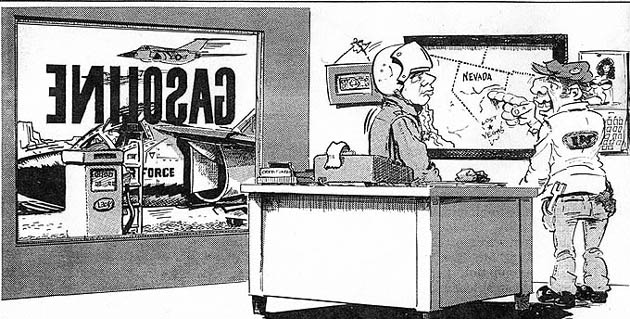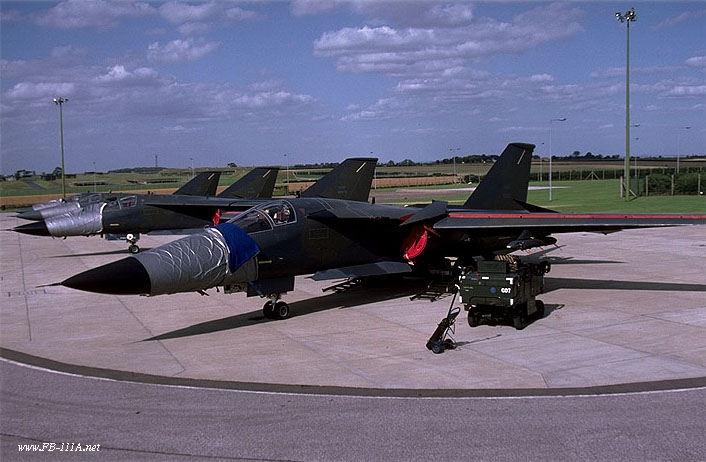
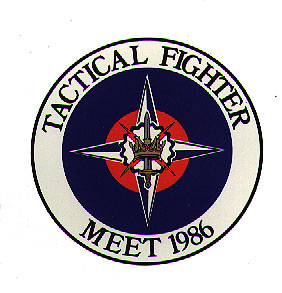
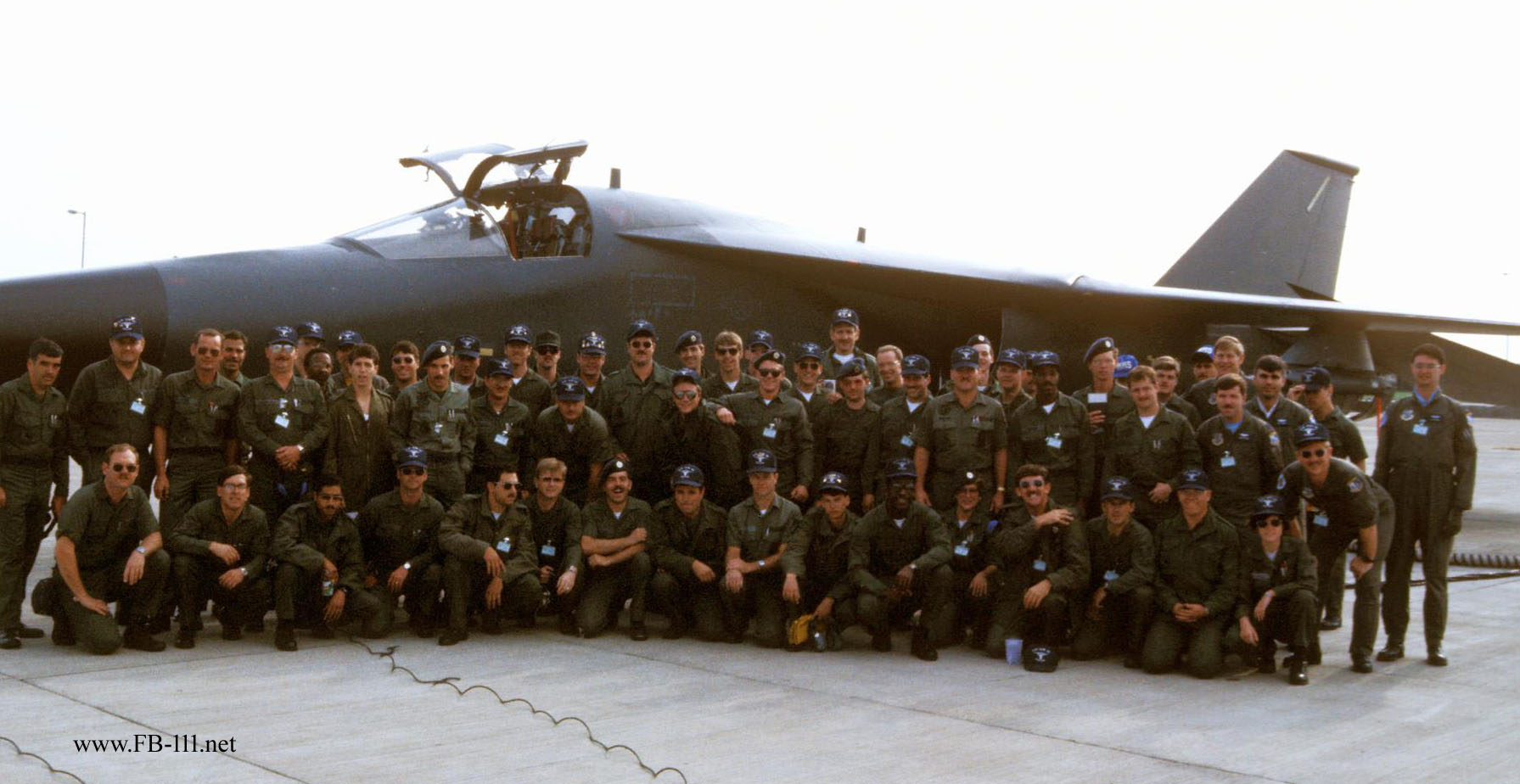
The 509th BW represented Strategic Air Command at the United Kingdom Air Tactical Fighter Meet 1986, a NATO exercise hosted by the Royal Air Force at RAF Waddington. Operation Tea Party involved two phases; an initial deployment to and operations from RAF Lakenheath from 15-30 July and a subsequent deployment to to RAF Waddington for the TFM from 30 July to 10 August. The 509th BW sent 86 personnel, five FB-111A and the necessary maintenance equipment for this operation. The six primary aircrew were selected from the 393rd and 715th Bomb Squadrons. Experience levels included a mix of young and olds heads which proved to be a winning team.
On the morning of 19 July at 02:58, the first tanker of a three ship cell launched with the others following at one minute intervals. At precisely 03:02 the five FB-111s aircraft launched using MITO procedures into the dark New England morning. South of Bangor, Maine, the three takers flown by 509th AREFS aircrews rendezvoused with the five FB-111s and flew east into the rising sun. The first air refueling went as scheduled over Newfoundland with one tanker returning to Pease. The crews completed the final refueling an hour and a half later south of Greenland. This marked the halfway point of the six and one-half hour mission. Approaching the Scottish coastline, UK military air traffic controllers greeted the deployers and cleared the FB-111s direct to RAF Lakenheath. The tankers recovered to RAF Mildenhall. On short final for landing at RAF Lakenheath, crews were surprised to see a large group of "runway watchers" awaiting their arrival in the UK. US flyers found this to be commonplace and felt good knowing theyr were not alone in their enthousiasm for flying. RAF Lakenheath, home of the 48th TFW "Statue of Liberty Wing", is situated northeast of London in East Anglia. This marked the first FB-111 operation in the United Kingdom. The 493rd TFS hosted the Pease unit and provided great assistance in preparing for flying in the United Kingdom. The first in-country mission consisted of a three ship familiarization mission with a 493rd aircrew flying lead in a F-111F. The two hour mission included low level over the Scottish country-side at the minimum altitude of 250 feet, conventional bombing range procedures, and "bootlegged" air refuelings, all accomplished while avoiding "purple airspace" (i.e. Royal Family flights) and numerous restricted areas. For the FB-111 crews flying in this "uncontrolled airspace", the environment proved a welcome relief after years of stringent rules and procedures during stateside missions. On the ground, 493rd and 509th crews exchanged valuable insights into each other's primary missions. Pease crews learned much about conventional weapons employment and tactics. SAC's expertise in radar bombing proved of particular interest to the F model crews due to their limited training requirements in this area.
On July 30, the 509th BW moved to RAF Waddington and the Tactical Fighter Meet. The weather at Waddington was not the best for the 100 arriving TFM aircraft. Four hundred foot ceiling and driving rain kept the approach controllers busy with talkdowns (i.e.PAR approaches) for six hours, averaging an approach every four minutes. The first two days at RAF Waddington involved meeting the other participants and flying familiarization missions to the local ranges. Participants in the Tactical Fighter Meet came from the NATO air forces and stateside USAF wings. Belgium, Canada, Denmark, France, Federal Republic of Germany, the Netherlands, the United Kingdom and the United States aircrews from Langley AFB, Nellis AFB and Pease AFB made up the multinational force. Fighter aircraft included the Tornado, Mirage, Jaguar, F-4, F-5, F-15, F-16, CF-18, EF-111, FB-111, Lightning, Draken and the NATO E-3 Awacs. For the local "runway watchers" this great collection of fighter aircraft provided a real treat.
Prior to each day's mission, Orange and Blue Forces received a weather briefing, restricted area brief and a ROE (rules of engagement) discussion. Once Orange Forces departed, the Blue Force was briefed on the intelligence scenario, ground and air threats, targets, and TOT (time over target) with ingress and egress routing. The Blue commander then summarized his plan of attack. Following the brief, crews mission-planned assisted by RAF flight liaison officers. Each day's mission flew a different random low level route which required attacking target complexes from new axes. the 509th staff planners developed unique low level missions folders including radar predictions within three hours of each flight, definitely not the standard stateside STR missions. These procedures proved accurate and invaluable aids to the crews.
Unlike the sterilized Red Flag and Maple Flag missions, TFM crews conducted operations over the entire United Kingdom conutryside and competed with normal civil air trafiic on a "see and avoid" basis, a very real need for heads up flying to ensure safe operations. After a thorough formation brief, it was out to the ramp to preflight. Taxi and take-off timing was critical due to the large number of aircraft and the single runway operation at Waddington. Seven minutes after taxiing, four FB-111s were airborne and on the way leading the Blue Force package. Using minimum risk corridors and terrain masking, Blue Force ingressed the target aera avoiding both weather and simulated surface threats. FB-111s used their supersonic capability on overwater legs. Appraoching the Spade Adam Bombing Complex, aircraft encountered realistic threats including explosive AAA and Smokey SAM similutors. Besides countering these ground threats, Blue Force had to avoid the Orange Force while acquiring the target on radar and visually. Targets included heavily defended runways, GCI sites and numerous SAM and AAA sites. Following release of MK-106 practice bombs simulating MK-82s and CBUs, Blue Forces egressed at high speed. Coming home, the Blue Force still evaded Orange Forces; however, because the FB-111s carried AIM-9Ls, these were not one-side encounters. In fact, FB-111 aircrews successfully engaged Orange Force Tornadoes, F-16s and F-4s attacking their flights.
TFM aircrews accomplished VFR recoveries to a congested traffic patterns of up to 70 aircraft. During the five days of the TFM, aircrews accomplished all recoveries without closing the runway, a true indication of thei professionalism. Following maintenance debrief, crews recounted the mission to RAF flight liaison officers and assessed mission success.
At 16:45, all TFM participants gathered for the daily mass debrief. Crews evaluated their success against the targets aided by computer enhanced imagery and watched video tapes of terminal threat reactions. Lessons learned were discussed between teams and everyone left the briefing with a better insight into capabilities and limitations in a combat situation as part of a multinational force.
For the aircrews, operations and maintenance personnel returning to the States, Pease was a welcome sight after a demanding three and one-half week schedule. The aircrews cam away with a better understanding of flying in the European conventional theater. They received realistic training attacking targets heavily defended by both ground and air threats. The crews also learned to fly in large, multinational packages rather than the standard single ship ingress. They saw the value of mutual self-defense in combat situations. Finally, meeting the NATO allies, exchanging ideas, talking about "the threat" and understanding how a European conventional war might be fought fulfilled the crew's goal of successfully participating in and representing SAC at the United Kingdom Tactical Fighter Meet 1986..
During one week in August 1986, more than seventy aircraft from eight nations participated in the first major NATO event of its kind to be held in Britain, code named "UK AIR 86". The primary objective of this meet was to offer a unique opportunity for NATO air forces to operate jointly in a simulated hostile environment and from a single air base, RAF Waddington. A complex serie of missions was flown over a five-days period against defended target areas simulating the Central Region of Europe. A lot of emphasis was put on the use of ECM on the ground and in the air with the help of EF-111 Ravens from the 20th TFW at RAF Upper Heyford, RAF Nimrod AEW.3 and NATO E-3 A Sentry.
The 509th BMW was tasked by CINCSAC to participate in the Fighter Meet under 'Operation Tea Party'. When the FB-111A force shifted its emphasis to conventional bombing, NATO became its main focus of operation and this exercise was a welcome opportunity to train in different conditions.The 509th BMW was able to demonstrate its ability to deploy, employ and successfully complete a conventional mission scenario. Six integral crews were selected to participate in the exercise and since it was to be very demanding and required a high level of expertise, inexperienced crews were excluded from selection. An extensive local training program was developed to prepare each aircrew for conventional visual bombing tactics and composite formation flying. Ground training classes concentrated on visual bombing procedures and to familiarize aircrews with preflight of the SUU-20 dispenser, and the specifics of MK-106 employment. The 509th BMW deployed five FB-111As and two KC-135s in support of Operation Tea Party on July 19, 1986. The five FB-111As; 63-7196 "Ruptured Duck", 68-0257 "Next Objective", 68-0267 "Memphis Belle II", 68-0273 "Milk Wagon" and 68-0275 "Bomble Bee" deployed to RAF Lakenheath for training operations in preparation for the TFM. While at Lakenheath, 509th's aircrews were helped by 48th TFW's aircrews in local procedures and conventional weapon delivery tactics and procedures. The 509th BMW deployed to RAF Waddington on July 30 in preparation for the actual meet which was held between August 4 and 8. This was the first time the Strategic Air Command had participated in an exercise of this type and the deployment proved to be very successful. The 509th BMW achieved a 100% sortie completion rate with 84 total sorties scheduled and accomplished during the deployment. This 100% sortie completion rate was directly attributed to the efforts of the maintenance team. Included in their efforts were four complete engine changes and repairing one aircraft with extensive damage due to a bird strike. Many lessons were learned during the TFM. The actual exercise identified several areas where training programs could be improved to benefit future similar type missions such as Red Flag and Maple Flag. One benefit from participating in those exercises was to define what an FB-111A could and could not do. When compared to smaller fighter aircraft, its heavier payloads, increased range and high speed must be emphasized while its large size, limited maneuverability and poor cockpit visibility should be mentioned. Specific rules limited one of the FB's most unique capabilities, its all-weather TFR flight. UK low level rules specifically prohibited IFR TFR, either day or night. Following the exercise, many recommendations were offered for future conventional training exercises. For maintenance, the major lesson learned was that proper anticipation of problems and in-depth planning prevents major difficulties. Problems encountered of a major nature were the following; engines changes, double throttles cable change, 12 fuel leaks in both engine bays on one aircraft, wing interconnect fuel leak, bird strike destroying radome and leaking fuel manifold.
Some highlights of the FB-111A participation included the most consecutive 'Code One' sorties; 11 by "Ruptured Duck". "Bomble Bee" was credited with most 'kills' of all FB-111A armed with AIM-9 missiles: two Tornado aircraft, one F-4, a Belgian F-16A, a USAFE camera crew, a maintenance line shack and a seagull! The bird strike destroyed the nose radome and the aircraft recovered at RAF Lossiemouth.A little known fact is that the FB-111A had an air-to-air capability. Prier to the deployment, five aircraft were "temporarily" modified with the requisite W-24 wiring to the stick for stations 4 & 5. FB #193 blew a spoiler actuator on taxi out and was quickly replaced by 273 just back from Depot. That jet did not have the wiring installed.The 509th BMW redeployed from RAF Waddington to Pease AFB on August 9, 1986. In conclusion, the 509th's participation in UK-AIR Tactical Fighter Meet 1986 was accomplished with outstanding results. In a new and demanding conventional role, the 509th's crews produced outstanding bombing scores. On occasion, they were the only element in the strike package able to successfully penetrate, locate and strike the assigned target. UK AIR allowed 509th's crews the opportunity to increase their low-level flying proficiency by operating away from their standard mission profiles.
For the "old heads", it brings back unpleasant memories of excursions to Hanoi and Haiphong. For the "new guys", it's hair-raising introduction to a classic situation - "Hey, they're shooting at me!" It's called Red Flag, the closest thing to a wartime environment.Landing at Nellis AFB, Nevada, is like flying into a combat zone. The ramp is crowded with fighters camouflaged in their war paint, "sandy" rescue helicopters, gunships, ad now, SAC FB-111s. Crew heading for their aircraft have the grim-but-determined look of men about to prove themselves, and a sweat-soaked F-4 crew stumbling from their cockpit look as though they have been through the proverbial "valley of the shadow of death". Maintenance teams seem intent on refueling and rearming their birds in the shortest possible time. The atmosphere infects the FB crews even before they report to the Red Flag Center for the orientation briefing.There is a war on. Intelligence briefs that the enemy Red Force has taken over a peaceful country north of Las Vegas. In support of the lawful government, the allied Blue Forces are launching coordinated attacks on the invaders. The FB-111s will operate as single ship, low altitude penetrators to strike airfields and enemy-held industrial complexes. The mission will be flown in accordance with SAC Tactical Doctrine, utilizing the terrain following radar, electronic countermeasures and chaff. Bomb-nav and defensive systems specialized briefings cover ingress and egress routes, targets and the air order of battle. The emphasis is exemplified by a familiar motto, "Our Mission is Bombs on Targets". The TAC Range Briefing stresses that safety is paramount. Despite the emphasis on realism, Red Flag is still a peace time training mission. Rules of engagement and radio procedures are covered in detail. If an unsafe situation develops, the phrase "knock it off" will terminate an air-to-air attack. At low altitudes and near-supersonic speeds, the margin for error is narrow, and while the enemy threats are simulated, the ground remains a 100 percent reliable danger.
As the sun came up the next morning, the flight of three FB-111s breaks ground and joins up into fingertip formation for the leg to the cell breakup and start descent point. Starting down the chute into low level, Plattsburgh's Crew S-04, was acutely aware that the next 150 miles of desert concealed mobile anti-aircraft artillery (AAA) and surface-to-air missiles (SAM) sites eager to claim a kill on the SAC 'invaders'. Crew E-13, coming in ten minutes later, were most conscious of the swarms of patrolling F-5 "Migs" of the aggressor squadron. Flying the "cleanup slot", Crew E-23 inherits the hornet's nest kicked up by lead and numbers two's hardly sporting, since the Red Force already knew the approximate routes, targets and arrival times of the bombers.As they level off and cross the line into enemy territory, the ECM systems are turned on and the chaff dispensers armed. In any game of hide and seek, the best way to avoid being "tagged" is not to be seen at all. The pilot concentrates on flying low and fast while the right-seater nurses his navigation equipment and tripple-checks the switches in the bombing system. Both crewmembers are constantly searching for enemy fighters and for visual landmarks to check their course. Being "shot down" is embarrassing, but getting lost is even worse. The first threat comes up, a SAM signal at two o'clock! Working as a well-drilled team, the pilot executes the proper defensive maneuver while his navigator operates the ECM. The enemy radar loses them. Did they track the bomber long enough to claim a kill? The crew won't find out until the post mission critique, but for now they press on, getting back on centerline and waiting for the next attack. Behind them, the second FB-111 evades an AAA gunner and then gets picked up by a Marine F-4. There is time for one quick jink before the fighter zooms past them. Later, the gun-sight camera film will tell the story. By this time, Red Flag has stopped being a game in the minds of the crews as they fight to reach their targets. Approaching the initial point (IP), target area defenses saturate the ECM but now the navigator's world narrows down to his bombing system and radar scope. The pilot accelerates and turns to bomb run heading while the navigator concentrates on identifying the proper aim point - one mountain peak among dozens - in the radar. His crosshairs fall between two identical peaks. Which one is the off-set? He has less than 120 seconds to decide. The bomb-nav advisor had briefed that there would be a long, curved ridge line just to the north of the point, and there it is. Now, position the crosshairs and finish the checklist. Cross-check landmarks and time-to-release with the pilot. Here comes his visual timing initiation point, right where it should be. Refine the crosshair placement. Let's show them how it's done! At ten seconds to go, the plane pops up over a ridge and the pilot sees the target airfield straight ahead. Bombs away! and the plane jumps up as the 200-pound concrete bomb leaves the weapons bay. They break right into the post-release turn and execute the maneuver technically known as "Getting the _____ out of there", hugging the tree tops and running the gauntlet back to friendly territory.
After climbing out for the short leg back to Nellis, it's a temptation to check the wings for bullets holes and to start composing a citation to accompany a Distinguished Flying Cross... But the real reward from red Flag is the experience of operating and surviving in a hostile air combat environment. The crewmember gains confidence in his aircraft, defensive tactics and his ability to "Strike and Return". For SAC FB-111s, Red Flag is something more than a training exercise. It's the next best thing to actual combat experience!
380th BW's FB-111A crews participating in this Red Flag exercise were: Crew S-04; Capt Warren Laws and Capt Rich Nowicki. Crew E-13; Capt Quentin Killian and Capt Joe McCue. Crew E-23; Capt Tom Larkin and Capt Rich Barringer.
(This story was written by Captain Bill Craig from the 528th Bomb Sqd and was published in the December 1978 issue of Combat Crew. It is reproduced here with his permission.)
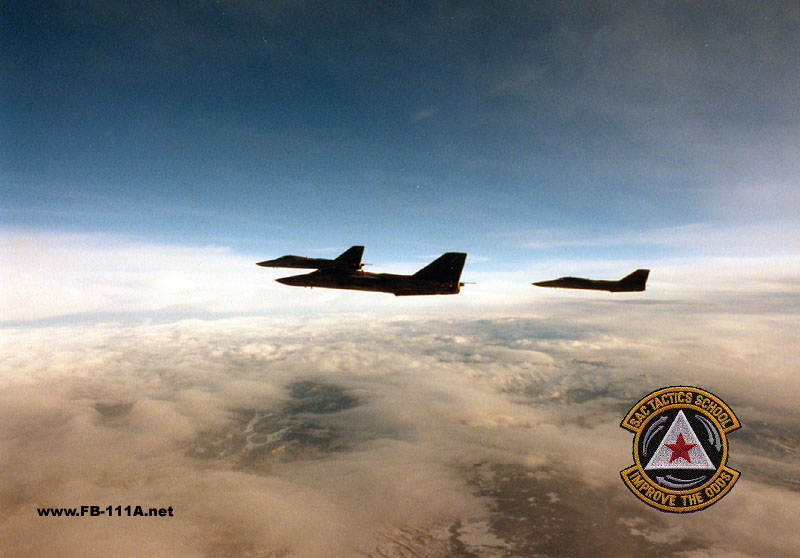
So it's your turn to go to Red Flag again, or perhaps it's the very first time. In either case, you should be fully prepared to "hit the ground running" when you arrive at Nellis AFB. trying to catch up on range procedures at the last minute in your hotel room isn't exactly my idea of a good time. In all seriousness, I have a few tips to offer in preparation for your next visit to Red Flag. Specifically, I'd like to go over how we, the 393rd Bomb Squadron Tigers, prepare for Red Flag in terms of safety, operating procedures and area orientation.From the very start you need to understand that flying in the Red Flag arena is a demanding flying environment. It is the most dangerous environment short of actual combat and therefore, safety is paramount. Flying at 1.3 Mach at 200 feet above the ground doesn't give you much of a margin for error - and remember the ground has a PK of one. So again, the most important item to emphasize is safety. Have you operating procedures down cold. As soon as you receive the Special Instructions (SPINS), spend time going over the package. Talk to others who have been there if you don't understand a procedure. Our squadron spens time during each hanger flying meeting discussing these operating procedures in depth. The better you know the procedures, the easier it will for you to concentrate on other areas.Another area to discuss is ego control. It's very easy to get caught up in the excitement of Red Flag and let your ego get in the way of common sense. We're at Ref Flag to learn and practice new techniques; if in that process we are "shot down" by an agressor we have learned something. So know your own limitations and don't let all that talk at the bar influence your common sense. Situational awareness is a key factor that deserves attention. You will be face with some of the most intense situations you have ever encountered. Between keeping an eye out for other aircraft (Nellis Control averages more than 400 sorties daily), evading the agressors, jinking around the theats, and attacking the target, you must be constantly aware of your environment. This situational awareness involves knowing where you are, what comes next and constantly being in control of your aircraft. For the pilots this means keeping your eyes outside the cockpit. The problem of optical illusion is a constant factor during Red Flag missions. For most of us the featureless desert gives a false sense of altitude. The flat terrain lacks definition and thus causes a depth perception problem. Such terrain features as sage brush versus trees may cause you to reduce altitude to make the sage brush look like the trees that we are all used to flying over. In the steep mountainous areas, a false horizon in rising terrain can cause an insidious illusion of a ridge line being lower than it actually is and thus not allow sufficient time to clear the top. An additional problem is presented by the time of day and the relationship of the sun. Certain positions of the sun cause mounatins to blend into shadows and hide the terrain. Late in the afternoon the sun may be directly in your eyes. These factors make it even more important to rely on our terrain-following radar capability.Another area of particular interest is reviewing the lessons learned by crew who have been there before . Cross-talk of mistakes previously made might save you a little embarrasment, teach you better techniques or more importantly save your life. The "old heads" in our squadron have put together a slide show of a typical Red Flag deployment which is most beneficial to first time crews. After viewing the slide presentations you can also begin to develop a feel for what to expect in terms of terrain features. In addition to viewing these slide shows, each crew member plots his own map of the Nellis ranges. Of particular interest is the correct plotting of area boundaries and restricted areas. Since most of your flying will be "heads out of the cockpit", study the maps for prominent landmarks such as Coyote Peak, Student Gap, Mt Irish, Belted Peak, Cedar Peak and Mt. Worthington. These important landmarks will be a definite aid for orientation on your first mission across the Nellis Ranges. Plastic relief maps or "bumpies" are another helpful tool in area orientation. These maps help you visualize the high peaks and low flats, and allow you to select your route of flight in detail using terrain masking to your advantage. Once you have studied the range maps you should next become intimately familiar with the detailed departures and arrivals of Nellis AFB. These procedures were designed to allow the maximum flow of traffic into and out of Nellis AFB in minimum time. So both crewmembers need to take the time and discuss these procedures. A very helpful technique is for the radar navigator to assist the pilot in calling out required altitudes and headings duirng departures and arrivals, especially in three ship formation. After indepth study of these departures and arrivals, we schedule each crew for a one and one-half hour simulator to practice these procedures.Hopefully these ideas will help your unit safely prepare for its next Red Flag deployment. Remember all the time you spend preparing at home will make your operation run that much smoother and safer. Be sure to keep a log of lessons learned to share with the new people in your unit. These tips apply to all units participating in Red Flag. I certainly haven't covered everything that you need to prepare for and I know you will have some things to add to my list. The flying at Red Flag is totally unique and very demanding, and I'm sure you'll feel challenged by the variety of the mission and the realistic training. Enjoy your next trip to Red Flag and remember above all else, fly safe!
This story was written by Brian Arnold from the 393rd BS and published in Combat Crew. It is reproduced here with the author's permission.
During Red Flag in 1977 with the 715th BMS.
The 380th Bomb Wing joined forces with the 509th Bomb Wing to set another first for the Strategic Air Command during a Red Flag exercise at Mountain Home AFB, Idaho in 1980. The purpose of the deployment was to integrate Pease and Plattsburgh's FB-111A crew members and maintenance personnel into conventional munitions deployment. At the time, Red Flag was the Tactical Air Command's realistic training program which allowed aircrews to experience simulated combat situations not encountered during normal training missions. This kind of exercise provided aircrews with a convincingly real setting for encountering their first "combat" missions. Nearly 12,000 aircrews have been trained in Red Flag between 1975 and 1980.The 380th and 509th Bomb Wings participated from June 4 to June 13. The head maintenance officer for the joint venture was Maj. Thomas Zavorskas from the 380th AMS and was in charge of 74 Organizational, Avionics, Field and Munitions Maintenance workers; people from Supply and mission debriefing from Pease and Plattsburgh. FB-111A flightcrews from the 528th/529th Bomb Squadron and the 4007 Combat Crew Training squadron flew under the one-team concept with FB-111A aircrews from Pease AFB. Ten flightcrews were sent from Plattsburgh to take part in this exercise.
According to Lt.Col. Raymund O'Mara, 380th Bomb Wing Detachment commander for the exercise, this was the first time FB-111 crew members and maintenance personnel had ever trained in conventional combat situations. "I feel this Red Flag was very successful," said Colonel O'Mara. "We had Plattsburgh aircraft flying in Pease formations and vice versa. It was also very impressive to see Plattsburgh and Pease maintenance personnel work together. We also had the added benefit of working with TAC crews from Mountain Home," added Colonel O'Mara. "We were able to gain knowledge from their extensive experience in conventional munition delivery."
Capt. Michael Kenny, a 528th BMS pilot stated,"This exercise was unique and historical. SAC is nuclear deterrent force and never before has the FB-111A been used for conventional purposes." According to Captain Kenny, this exercise was more realistic than other Red Flag exercises because there was a heavier concentration of planes in the air at the same time, making the missions more realistic. "It was interesting working with Pease and other aircraft besides the FB-111A," the captain added. "We were all trained at the same school, but have slightly different flying techniques. However, we could fly in the same aircraft without problems." When flying missions in the Plattsburgh area, the crews used mainly the radar and navigation systems to find targets. With conventional flying, they got to plan and attack. "It's a great feeling to know we can go anywhere with the FB-111A and work with Pease and encounter no problems," stated MSgt. John Dempsi, maintenance superintendent. "The whole exercise was outstanding. We had maintenance members working side-by-side with Pease personnel. If the situation ever arose where we would have to use the training, we would be able to do the job perfectly together."Colonel O'Mara summed up the exercise, "This Red Flag proved to be very educational for the Wing. The purpose was to expand the use of the FB-111A and train crew members and maintenance people in conventional munitions delivery. It was our first step. We have a long way to go, but we learned quite a bit."More than 150 aircraft participated in this Red Flag, including SAC B-52D, G and H models, FB-111A and KC-135s. This largest-ever Red Flag exercise at the time involved more than 2,300 people and more than 5,000 individual aircraft sorties.
